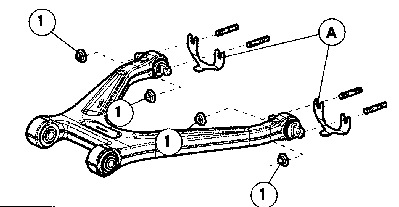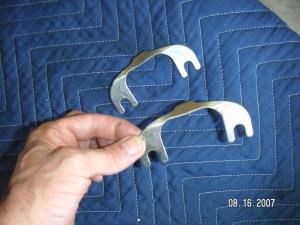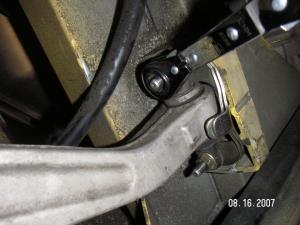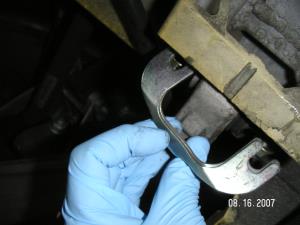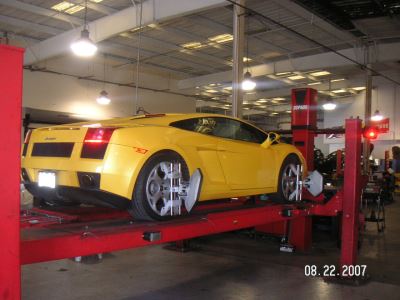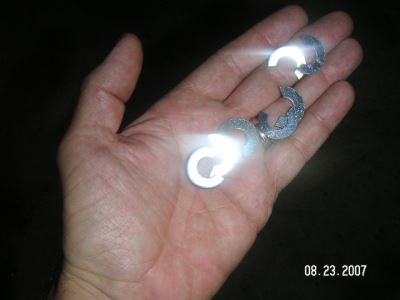| |
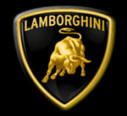
|
|
|
|
||
|
||||||||||||||||||||||||||||||
Wheel Alignment 101There are 3 main components that need to be taken into account to make sure all 4 tires of a car meet the road correctly. They are called "Camber", "Caster" and "Toe In".
Camber is the angle of the wheel, measured in degrees, when viewed from
the front of the vehicle. If
Castor
Toe-in
Four-Wheel Alignments There are two main types of 4-wheel alignments. In each case, the technician will place an instrument on all four wheels. In the first type the rear toe and tracking is checked, but all adjustments are made at the front wheels. This is done on vehicles that do not have adjustments on the rear. The second type is a full 4-wheel alignment where the adjustments are first made to true up the rear alignment, then the front is adjusted. A full 4-wheel alignment will cost more than the other type because there is more work involved. For a Gallardo we need a 4 wheel alignment. Other facts every driver should know about wheel alignments.The Suspension System of a Gallardo As you might expect the suspension system of a Gallardo is a little bit more complex. The car has a double wishbone front and rear suspension, an anti-roll bar, and anti-dive and anti-squat 'self adjusting' Koni FSD dampers. Unlike many "standard" cars, the camber and toe-in is not adjusted by adjusting an bolt or two. Instead, the lower wishbone where is attached to the frame of the car is moved in or out by inserting metal shims between the frame and the wishbone.
This very simple arrangement is quite effective and easy for a technician to do. To adjust the camber you just add or remove both shims (A in figure 2). This has the effect of pulling in of pushing out the base of the wheel. The shims are held in place by two bolts (figures 4 & 5). You simply have to loosen the bolts for the shims to drop down. To adjust the toe-in you add or remove one or more shims from the front or back (but not both) attachment points. It's the same process for the front or back wheels. This is in marked contrast to the setup on say a Ferrari 360 where you need a special tool to get to the to the shims that are on the top wishbone of the front wheels. OK, this is all and fine, but how do you measure wheel camber, toe in and castor. Now there are several write-ups on the web describing how you can do a wheel alignment yourself at home using a string, spirit level and plum line. However for something as important as this your best bet is to go to a tire alignment shop and get is accurately done by somebody who knows what they are doing. There are several alignment machines that use laser beams to really accurately measure your wheels. "Hunter " is one well known brand. A typical setup is shown in Figures 6.
The only complication is that most machines do not have Lamborghini cars in their computer database. If this scares off the technician you are probably going to the wrong guy anyway. For a Gallardo let them set it up as a Ferrari 360. What they do need is the wheel settings. Here is what I have from the '05 factory manual. It is probably the same for all Gallardo's. As you can see there is no Castor adjustments.
Now in my case for a less negative camber I had to remove shims. If you need to have a more negative camber (for example track racing etc), you will need to insert extra shims. Lamborghini supply these in 0.3, 0.5, 1, 1.5, 2, 2.5 and 3mm thicknesses. Of course your corner alignment shop will not normally have these in stock. What can you do. Well if you are not in a rush, order a batch from your Lamborghini dealer or web sites like LamboStuff. If you need something in a hurry you can make temporary shims out of different sized washers (fig 7) and use these to exactly determine the shim thickness you need. You can order this size from Lamborghini or cut your own from some aluminum strips. Use a micrometer to make sure you have the right thickness. Tires The standard Gallardo comes with Pirelli PZero 235/35/19 on the front and 295/30/19 on the back. Unlike most cars you have to be careful with Lamborghini cars that the outside diameter of the rear and front tires exactly match those supplied with the car from Lamborghini. This is because these cars have a "Viscous Traction" (VT) front/back differential system that mechanically springs into play if it detects slippage in the form of a rotational difference between the front and rear tires. Its a great system that really prevents burning rubber with fast starts etc. but is a pain in that you really have to be careful which tires you use. If there is a diameter mis-match the VT system will be working all the time and will over-heat/burnout. There is a great web tool for calculating tier dimensions at Miata.net. Now all of the above would not be much of an issue if it was not for the fact that Pirelli is a very poor supplier of tires like this to the US. Currently the Pzero 295/30/19's are back ordered at most shops --often by months! Fortunately I found that there is one alternative tier that has the same dimensions and characteristics as the Pirelli 295's. They are the Michelin Pilot Sport PS2's. After much asking around I found that a number of people are using these on their Gallardo's and are very satisfied. They even seem to ware better -- but for me only time will tell that. Since there is little ware on my front tires I went with just PS2's on the back. The tread pattern is essentially the same as Pirelli's and I have seen no handling difficulties well over 100MPH (on the track of course!). |
||||||||||||||||||||||||||||||
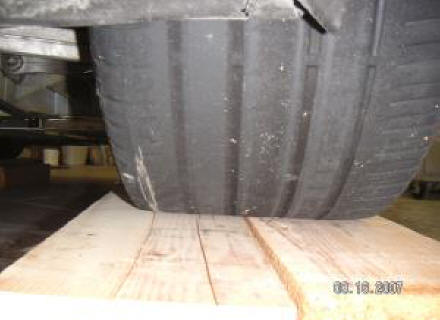
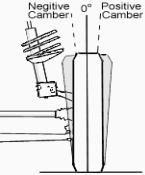 the
top of the wheel is leaning out from the center of the car, then the
camber is positive ,if it's leaning in, then the camber is negative. If
the camber is out of adjustment, it will cause tire wear on one side of
the tire's tread. If the camber is too far negative, for instance, then
the tire will wear on the inside of the tread. If the camber is
different from side to side it can cause a pulling problem. The vehicle
will pull to the side with the more positive
the
top of the wheel is leaning out from the center of the car, then the
camber is positive ,if it's leaning in, then the camber is negative. If
the camber is out of adjustment, it will cause tire wear on one side of
the tire's tread. If the camber is too far negative, for instance, then
the tire will wear on the inside of the tread. If the camber is
different from side to side it can cause a pulling problem. The vehicle
will pull to the side with the more positive 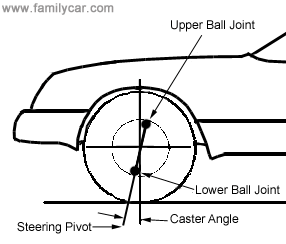 When
you turn the steering wheel, the front wheels respond by turning on a
pivot attached to the suspension system. Caster is the angle of this
steering pivot, measured in degrees, when viewed from the side of the
vehicle. If the top of the pivot is leaning toward the rear of the car,
then the caster is positive, if it is leaning toward the front, it is
negative. If the caster is out of adjustment, it can cause problems in
straight line tracking. If the caster is different from side to side,
the vehicle will pull to the side with the less positive caster. If the
caster is equal but too negative, the steering will be light and the
vehicle will wander and be difficult to keep in a straight line. If the
caster is equal but too positive, the steering will be heavy and the
steering wheel may kick when you hit a bump. Caster has little affect on
tire wear and can not be changed on the Gallardo.
When
you turn the steering wheel, the front wheels respond by turning on a
pivot attached to the suspension system. Caster is the angle of this
steering pivot, measured in degrees, when viewed from the side of the
vehicle. If the top of the pivot is leaning toward the rear of the car,
then the caster is positive, if it is leaning toward the front, it is
negative. If the caster is out of adjustment, it can cause problems in
straight line tracking. If the caster is different from side to side,
the vehicle will pull to the side with the less positive caster. If the
caster is equal but too negative, the steering will be light and the
vehicle will wander and be difficult to keep in a straight line. If the
caster is equal but too positive, the steering will be heavy and the
steering wheel may kick when you hit a bump. Caster has little affect on
tire wear and can not be changed on the Gallardo. 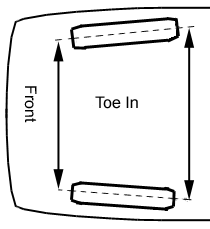
 The
tires should all be in good shape with even wear patterns. If
you have a tire with excessive camber wear, for instance, and you
correct the alignment problem that caused that wear, the tire will
now be making only partial contact with the road. (see illustration
on right)
The
tires should all be in good shape with even wear patterns. If
you have a tire with excessive camber wear, for instance, and you
correct the alignment problem that caused that wear, the tire will
now be making only partial contact with the road. (see illustration
on right) 